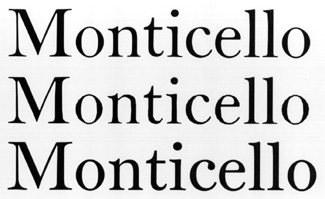dot-font: Mr. Jefferson’s Typeface

dot-font was a collection of short articles written by editor and typographer John D. Barry (the former editor and publisher of the typographic journal U&lc) for CreativePro. If you’d like to read more from this series, click here.
Eventually, John gathered a selection of these articles into two books, dot-font: Talking About Design and dot-font: Talking About Fonts, which are available free to download here. You can find more from John at his website, https://johndberry.com.
Thomas Jefferson wasn’t a typographer, but he took an interest in every kind of technology and scientific knowledge in his time, and he encouraged the development of homegrown American industry to promote the growth and independence of the new nation. When Archibald Binny and James Ronaldson, immigrants from Scotland who had established a type foundry in Philadelphia, asked the former president for his help in obtaining antimony (used in casting metal type) when their existing supply was interrupted by an international trade dispute, Jefferson helped them find a new source in France. And in later years, Jefferson expressed his admiration for the types of Binny & Ronaldson, which by the 1820s had become the most commonly used types in the United States.
Binny & Ronaldson was one of the first type foundries in the United States, established in Philadelphia in 1796.
Graphic tastes change, however, and Binny & Ronaldson’s “Pica Roman No. 1” was eclipsed by newer types in the middle of the 19th century. When it was revived in 1892, under the name “Oxford,” by the American Type Founders Company (a grand consortium of most of the US type foundries, formed in reaction to the competition of the newly invented typesetting machines), the typeface became a favorite of several of the foremost American typographers and book designers, including Bruce Rogers and Daniel Berkeley Updike.
Updike used it as the text type for his monumental two-volume study of the history of type, Printing Types: Their History, Forms, and Use (which had the secondary subtitle A Study in Survivals), where he described Oxford as a “transitional” design between the old-fashioned style of old face (such as Caslon) and the crisper but less readable “modern” style derived from the work of Bodoni and Didot. He praised Oxford very simply but tellingly: “I have used it for this book. It seems to me a type of real distinction.”
More than a hundred years after Jefferson admired the typeface that came to be called Oxford, Princeton University Press proposed to publish Jefferson’s complete papers, and C.H. Griffith of Mergenthaler Linotype suggested that it should be done in “a historically appropriate typeface, one with which Jefferson was intimately familiar and which he expressly admired” (according to the broadside that accompanies the new digital adaptation). With the help of P.J. Conkwright, book designer at Princeton, Griffith worked on developing a machine version of Oxford that could be used on the Linotype. “Together they strove to preserve the spirit and style of the original design while moving it to a radically different technology. It would take them six years to complete the roman, italic, and small-capital fonts in seven sizes (7, 8, 9, 10, 11, 12, and 14 points), each of which required a separate cutting.” They named the new Linotype version “Monticello,” in honor of Jefferson.

A resetting in digital Monticello of an illustration in metal of which C.H. Griffith wrote, “These enlarged letters show the rather lively variation in serif treatment and bracketing which contribute to the inherent readability of Monticello.”
But the Linotype, too, eventually became old technology, supplanted by the new. The Press’s printing program used Monticello in hot metal for many years, but by the 1980s they had to enter the era of digital typesetting, and they had to somehow adapt Monticello. Mergenthaler supplied a digital version that would work on the Linotron 202 digital typesetter, but there were many compromises involved, and with each new turn the typesetting technology took, the makeshift nature of this first digital adaptation of Monticello became more and more apparent. Finally, in 2002, Princeton University Press turned to Matthew Carter and commissioned him to create a new digital Monticello that could take advantage of modern typesetting systems.

The centerpiece of a broadside prepared to show the original Oxford foundry type, the hot-metal Linotype Monticello, and the new digital Monticello together.
Going Back to Roots
A digital font does not need to make some of the compromises that were necessary in adapting a design to the Linotype machine. It was no longer necessary for the italic alphabet and the roman to have exactly the same width (in most type families, the italic looks most natural when it’s a bit narrower than the roman), and there was no need to avoid overhanging kerns like the projecting ends of the italic f. While Carter’s brief was to adapt Linotype Monticello to PostScript, he also looked back to the original Binny & Ronaldson types and brought back some of the features that had been lost in the interim.

The development of digital Monticello: top, the unedited data supplied to Matthew Carter by Linotype; middle, a PostScript font converted from the Linotron 202 data, with tiny straight lines but no curves; bottom, the new digital Monticello.
One feature that had been added in the interim has been kept as an option in the new typeface. Although Oxford had, in keeping with the prevailing style when it was first cast, possessed only lining figures (uppercase figures, all of them the same height, though in this case not as high as the capital letters), when Linotype was developing a photo version of Monticello in 1973, it had added old-style (lowercase) figures as well. The new digital Monticello offers two versions of both the roman and the italic fonts: one with lining figures, one with old-style figures. (Matthew Carter told me that in the hot-metal version of Monticello, the small caps font that Linotype shipped with the typeface was in fact taken from Baskerville, and that before the advent of old-style figures for Monticello, printers had to take them from other fonts; the old-style figures from Caledonia worked surprisingly well.)

The Linotype outline character with the new digital version superimposed on top of it. “This shows,” Carter says, “that the weight was not added by dipping the too-light version in chocolate, but by selectively putting more on the serifs than on the upright strokes.”
Since the digital Monticello is intended primarily for book work, it has to appear strong and dark at small sizes. It has none of the spindliness that sometimes appears in digital (and photo) adaptations of metal typefaces. Compared to the 12-point Linotype Monticello, digital Monticello’s characters are a bit wider, more like the proportions in the smaller sizes of the metal type. The fit of the letters seems a little bit tighter, especially at small sizes (though in digital typesetting the spacing can be varied easily enough, for good or ill).
While it’s fascinating to pore over the broadside prepared by Charles Creesy of the Princeton University Press and compare the settings of Oxford, Linotype Monticello, and digital Monticello at various sizes, what counts to most of us is whether the new version works. It does. It’s a comfortably readable face in a style that now looks old but familiar to us, and it should lend itself quite well to book typography. I can easily imagine Monticello, in its new form, becoming a very popular book face once again.

A sample of digital Monticello used in text on the broadside prepared by Princeton University Press.
In Use Today
When Matthew Carter gave a talk last winter to the American Printing History Association, at the Grolier Club in New York City, about the creation of digital Monticello, APHA vice president Paul Romaine distributed as a keepsake a little sample that brought the typeface full circle. It was a single sheet, folded into a four-page booklet, which reprinted a short letter that James Ronaldson wrote to Thomas Jefferson in July 1822, and Jefferson’s even shorter but cordial reply. Ronaldson had sent Jefferson a specimen of his company’s latest printing types, and had bragged a little (justifiably) about how he and Binny had helped establish type-founding in the United States (“there are now in the US six letter foundries, and several Stereo ones, with the probability there will be more…”).
Jefferson thanked him and observed, “Altho’ increasing debility warns me that it cannot be long before the transactions of the world will close upon me, yet I feel ardent wishes for the continued progress of science and the arts, and the consequent advancement of the happiness of man. When I look back to Bell’s edition of Blackstone (about 1773) and compare his with your types, and by the progress of the last half century estimate that of the centuries to come[,] I am cheared with the prospects of improvement in the human condition, which altho not infinite are certainly indefinite.” The keepsake was set in digital Monticello but printed by plates on a letterpress by Kallemeyn Press—a fine melding of technologies from different eras.

The cover of a keepsake printed for the American Printing History Association to celebrate the launch of digital Monticello.
The first use of Monticello in a book will be in Volume 31 of the Jefferson Papers, to be published in early 2004. The digital fonts are available from Linotype Library; or directly from Carter & Cone Type Inc.—cherie@carterandcone.com or 800-952-2129—at $40 each for the individual fonts (there are six, counting roman and italic with both kinds of figures, a small caps font, and one with tabular figures and fractions), or, as Carter says, “$200 for The Full Monti.”
This article was last modified on February 24, 2022
This article was first published on August 25, 2003





Great invention.
payday loans canada
I liked reading about Thomas Jefferson wasn’t a typographer.payday loans canada